We climbed this iconic peak back on 1st September, 2017. This year we are both having trouble for various reasons walking to the front gate – but we will overcome! It is Qld’s highest mountain a little over 1600 metres situated just North of Innisfail approximately an hour South of Cairns. 1622 metres might not sound like much but you are beginning at about the 100 metre point. The track doesn’t really begin to ascend until after the Big Rock crossing and camp site at about 400 metres about 2 1/2-3 hours in. After that it is pretty rough going (growing steadily worse!) and straight up, in very hot, humid conditions. Though people (foolishly) do complete this trip in a single day, a great many regret having tried to do so. Most will find themselves walking for a number of hours over broken ground in the dark, which is ill-advised. It is not a day trip.
People should also be warned to take lots of water (four plus litres each probably) at least from the last source, Big Rock camp and stream crossing about 2 1/2 hours in.
You can (and should) download the topographic map (Bartle Frere) free from the Qld Government website (http://qtopo.dnrm.qld.gov.au/mobile/) and open it with the mobile phone App Pdf Maps or Avenza (http://www.theultralighthiker.com/restore-pdf-maps-functionality/) I now also highly recommend Paper Maps App.
This will allow you to use the GPS function on your mobile phone to ascertain exactly where you are throughout the walk. Your phone’s GPS will often take a little while to pinpoint your location. Leave it switched on and it will after a little while. The tree cover does not help. There are track markers at 1km (aerial, I suspect) intervals which will also help you understand exactly how far you have come/have still to go. Some of them are facing the wrong way and may be missed. I hope Parks can duplicate them so they are easier to spot, and perhaps include half km markers.
Mt Batrle Frere (centre) – view from the Johnson River Bridge North of Innisfail. The peak at the left hand end would be ‘Broken Nose’.
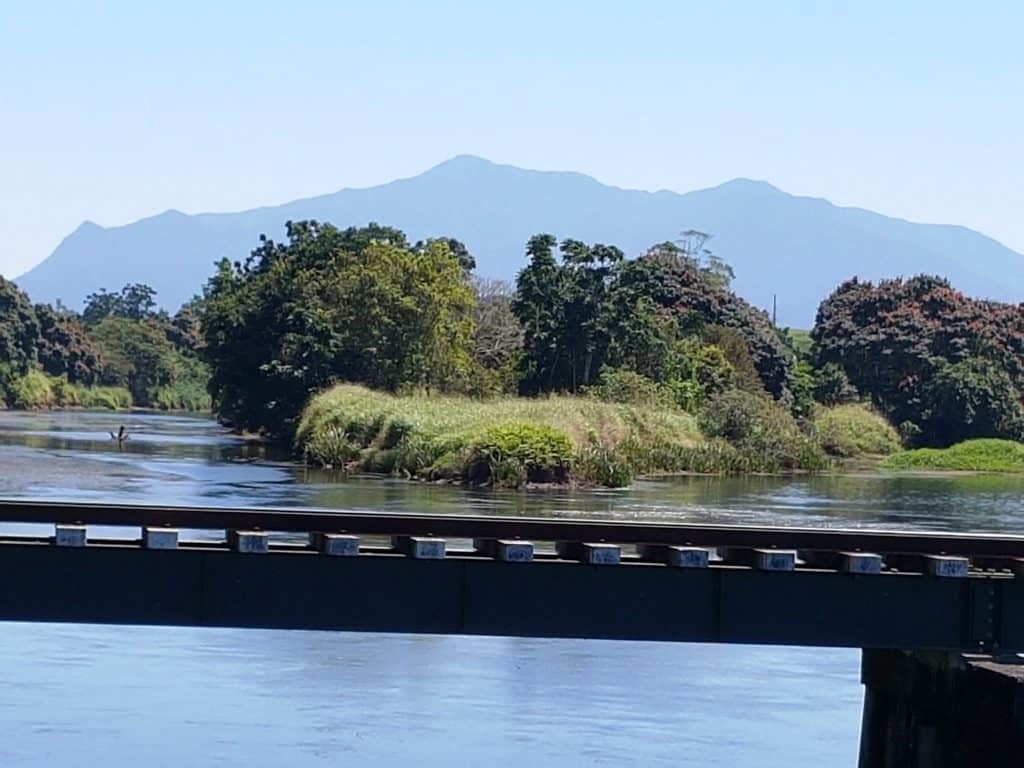
Mt Batrle Frere – view from Palmerston Highway. You can just make out (on these two photos) the short flat section where we camped just below and to the left of the summit)
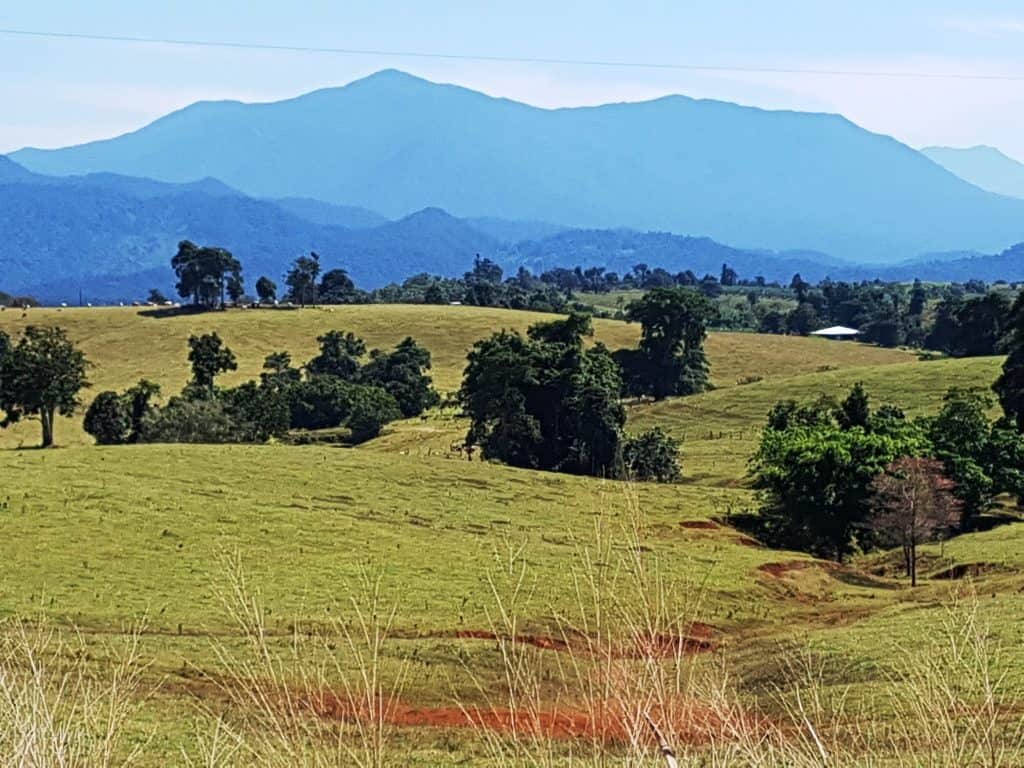
A very misleading signpost at the outset. Everything is bigger in Qld including the kilometres. Our pedometer Apps both claimed the distance each way was over 16,000 steps. Even allowing that one takes very much smaller steps on steep terrain, this is almost twice the specified distance on the sign. I repeat: It is very difficult (and likely very dangerous) to attempt this trip in one day. I think the sign should make that very clear. You should treat it at least as an overnight one, or longer – indeed, why not walk right through to the end of the track then come back again? We began shortly after 9:00 am.
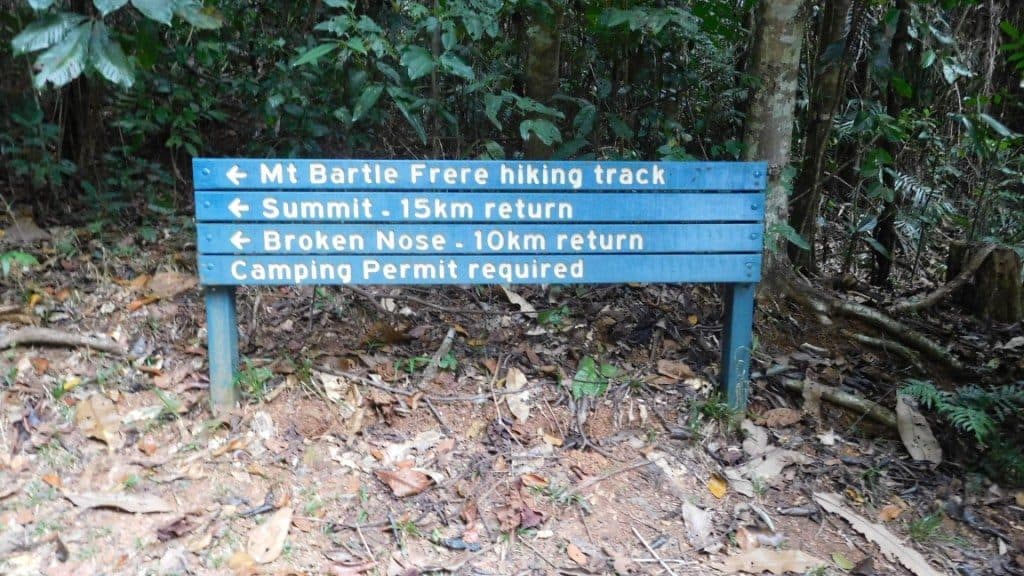
The first couple of kilometres are relatively flat and quite easy. This lulls you into a false sense of security.
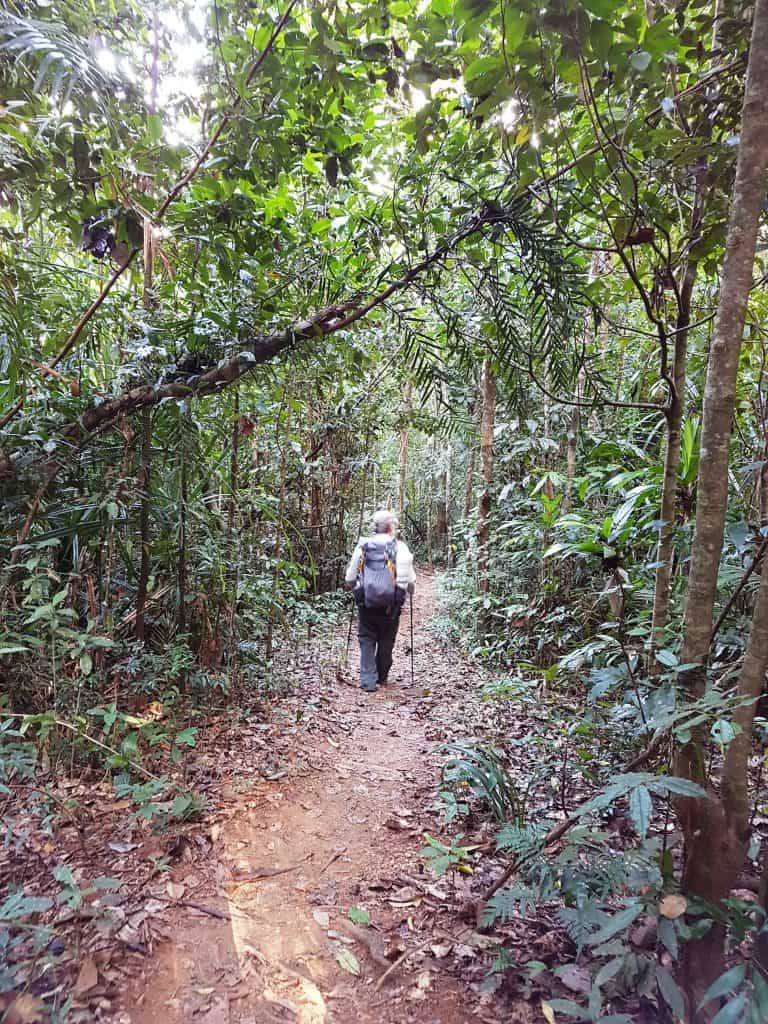
Many of the tropical trees along the way have the fruit springing straight from the trunks like this. Interesting.
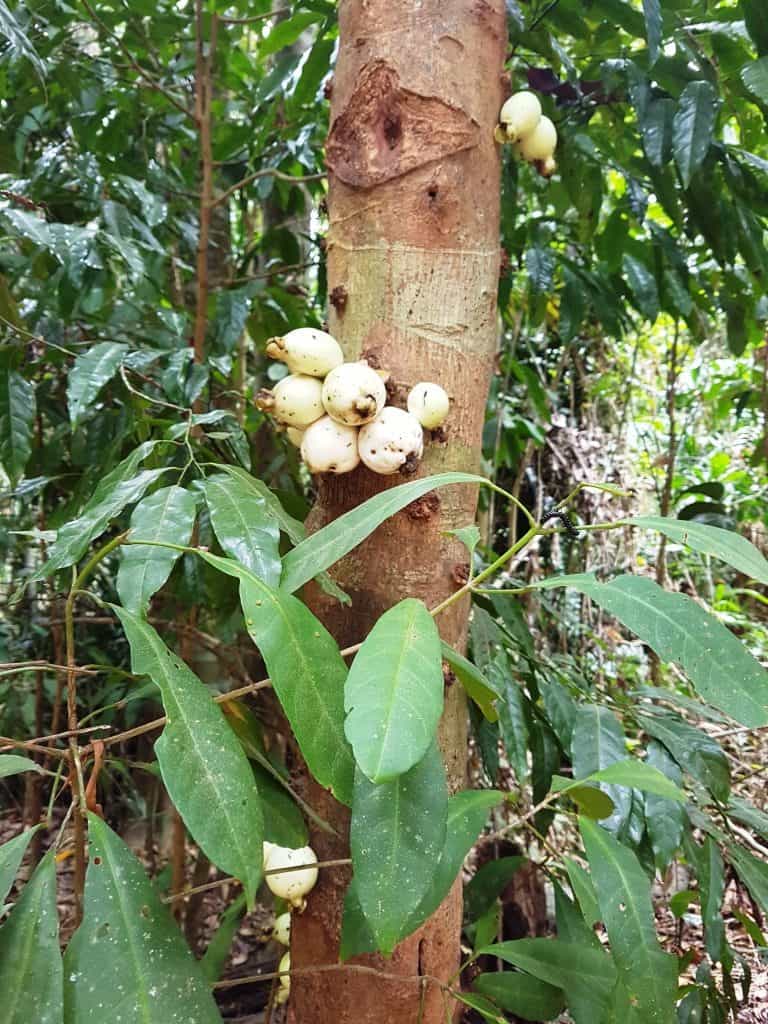
No doubt many are edible. there is a wonderful profusion of fruit lying on the forest floor.
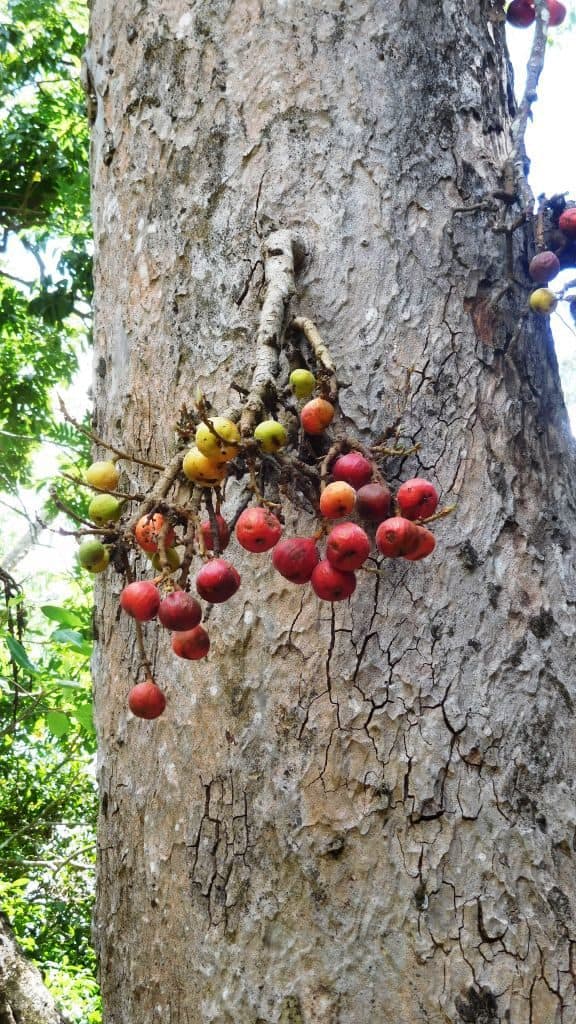
One wonders why there is not much more sign of cassowaries. There is a young one who hangs out near the Josephine Falls. After that we saw no sign of any.
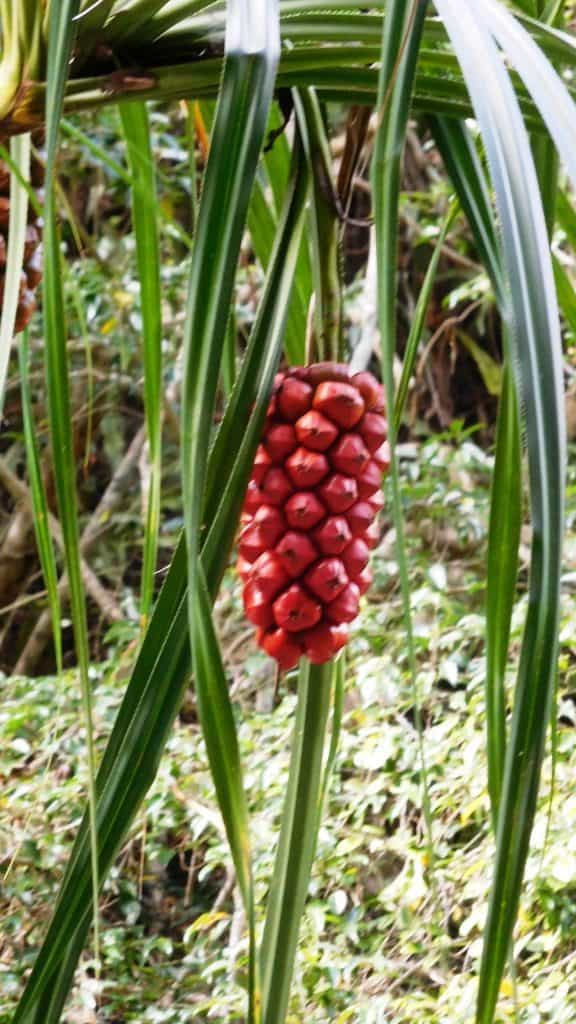
There are a couple of minor stream crossings such as this, and you begin to see large boulders indicative of the mountain’s volcanic origin. Notice the track is marked with orange arrows.
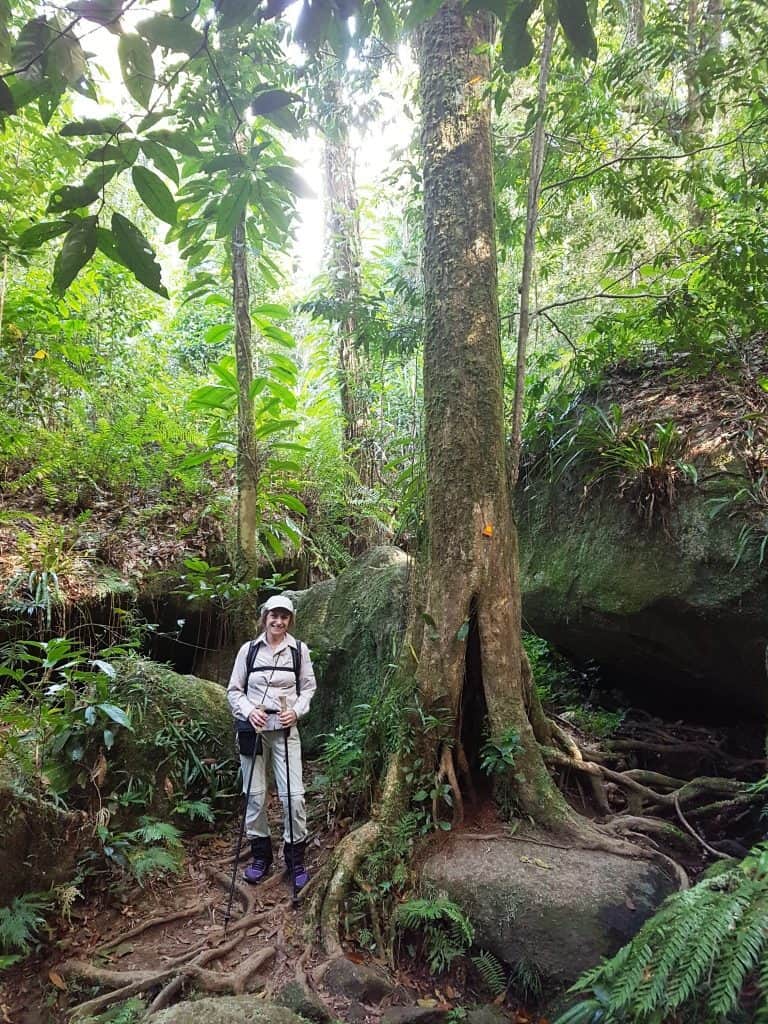
Of course you are walking through some splendid timber like this:
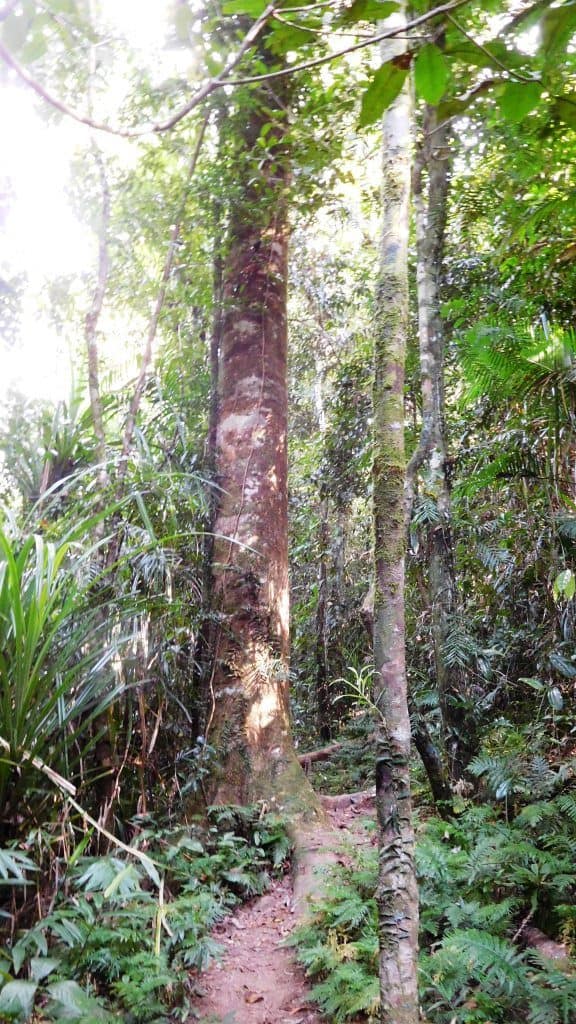
And this:
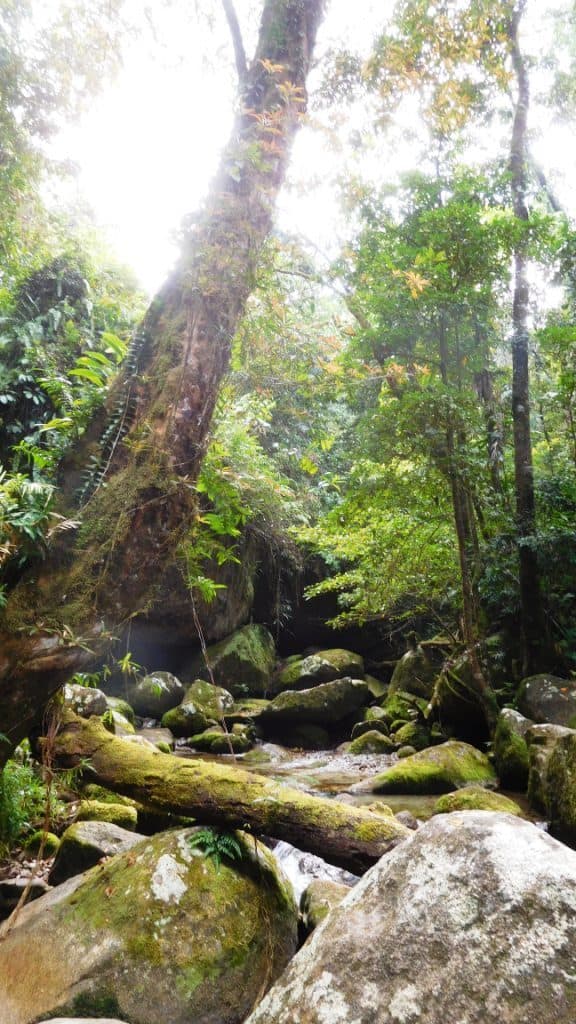
After a couple of hours you come to the first creek crossing. There are two. The other is at Big Rock camp.
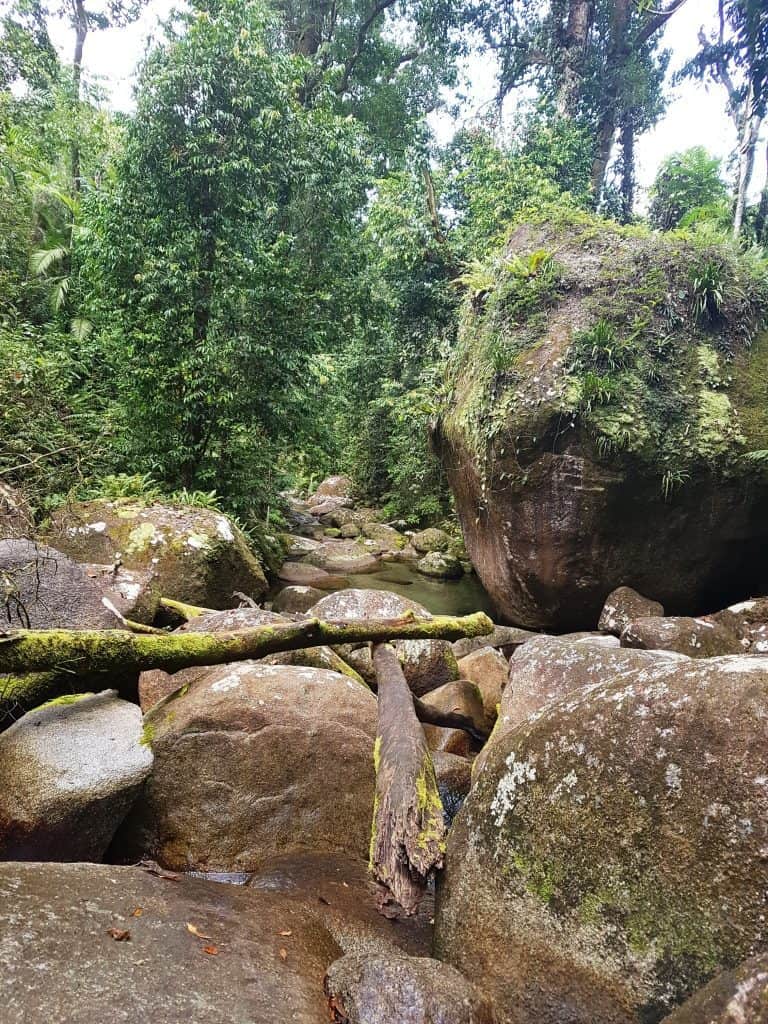
Quite beautiful.
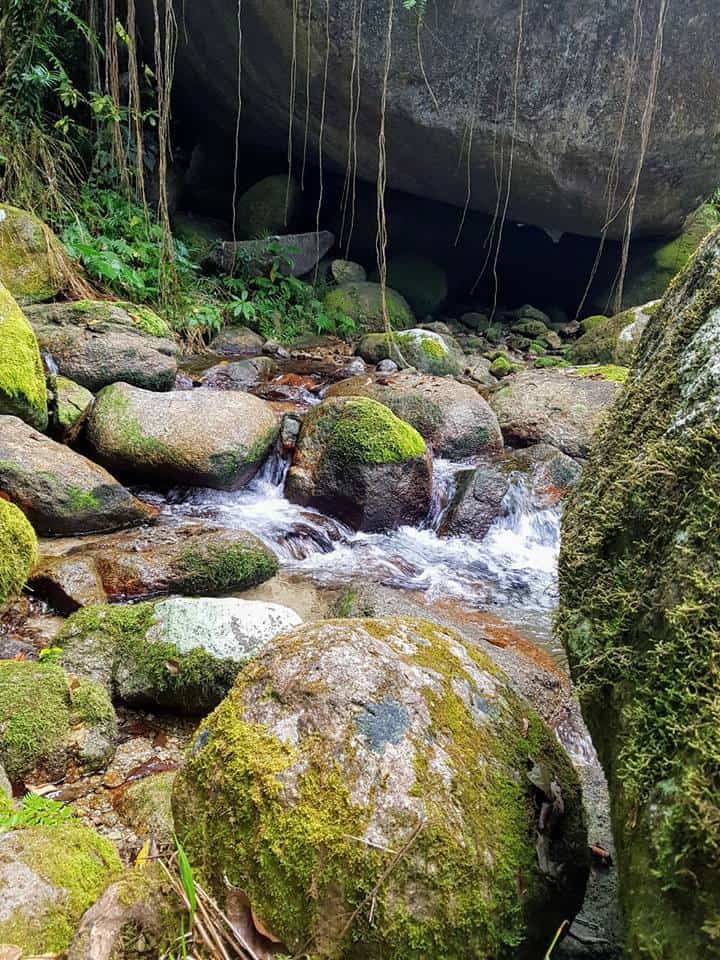
Some interesting fungi along the way.
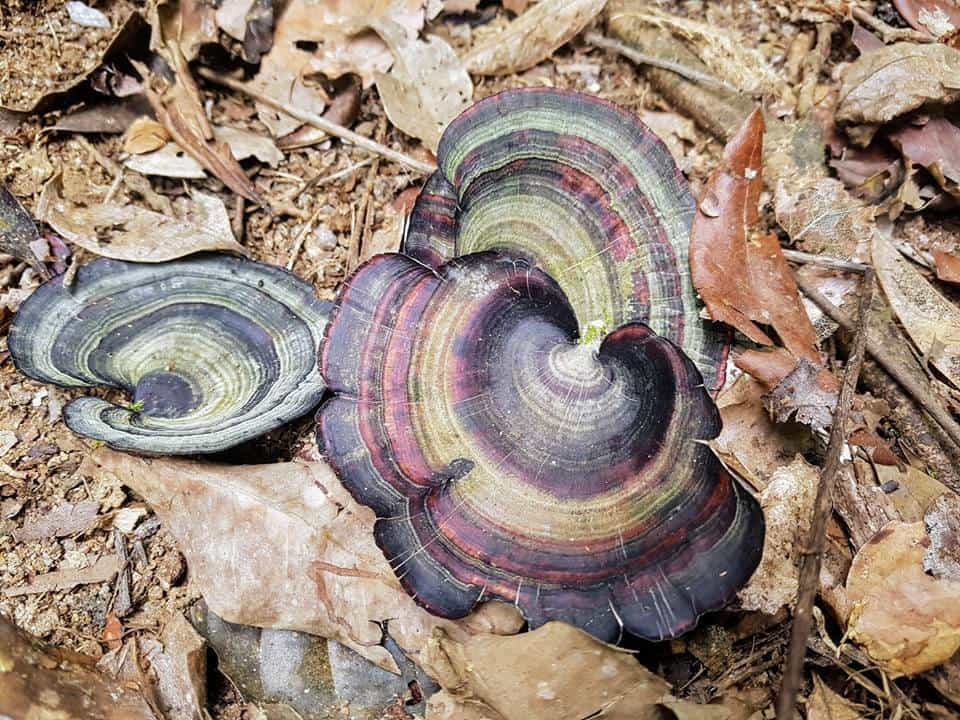
The next 1/2 an hour or so to the Big Rock crossing and campsite starts to become more difficult, The track is more broken and tending uphill. Like this.
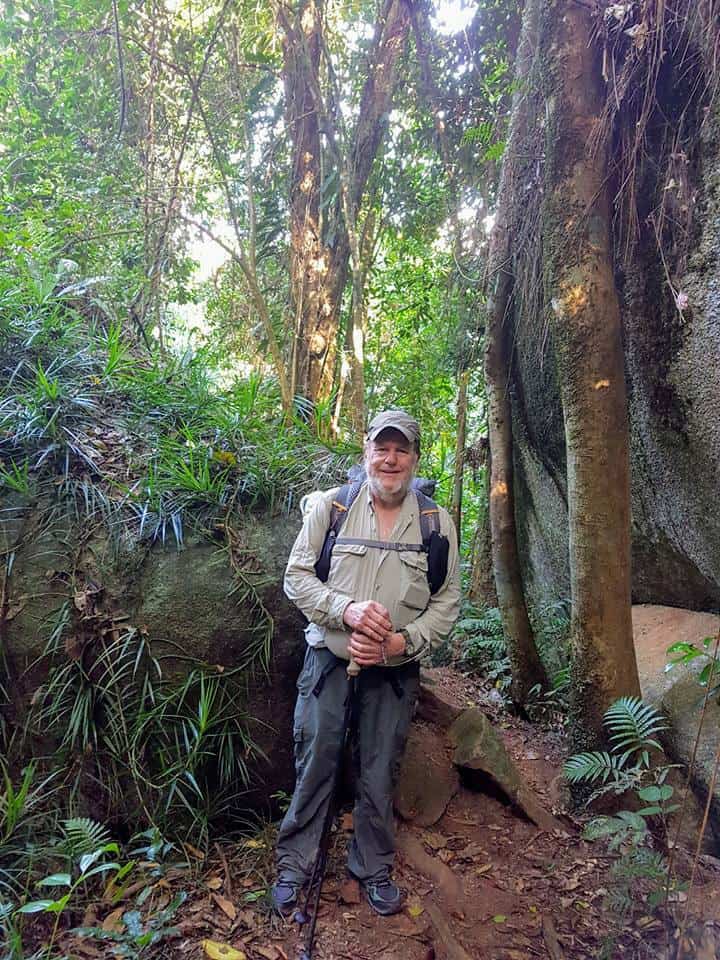
The stream crossing and campsite is quite well marked by this sign (Freshly washed. Really !) by Qld Nat Parks staff. I should have taken more snaps of the campsite and crossing but I got carried away with yarning to them. This is the first time I have ever seen public servants actually working in the bush – I opined to them that it would never happen in Victoria! They should think of ‘retiring’ there when they are my age!
The Parks staff were also concerned about people attempting the walk in one day as they have had many people getting into trouble and even needing rescuing (from the helipad). BTW: we had Telstra NextG phone coverage along most of the walk. Della even managed a Facebook post from our overnight camp just above the 6 km mark!
We left Big Rock at about midday and made camp about an hour from the summit at about 4:30pm. We were both happy to stop for the night!
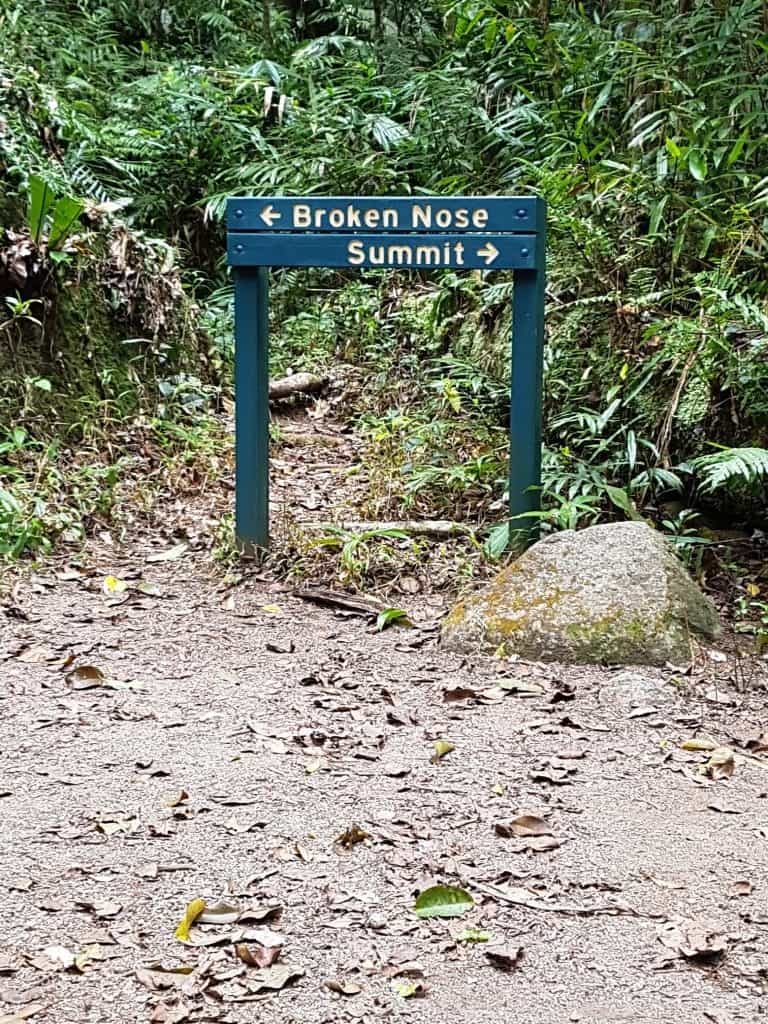
After the creek crossing it is pretty much up and up. You must carry all the water you need for the walk to the summit from this point. On the day we walked it was 28C max in Cairns. Every hundred metres we ascended it cooled by approx .8 of a degree so that by the time we were at the summit it would have been 15C max, and probably close to zero overnight. It can be much colder than that at the top. We both had our raincoats and puffer jackets on at the summit at 10:00am in the morning! Beware. Of course it can also be much hotter than 28C.
We managed with 5 litres of water between us for the return trip. We carried six. We saved water by not cooking a meal. If it were hotter you can easily see that you might need 4 litres of water each or even more! Be warned. We ran into a number of people on the walk who were clearly in distress for one reason or another! Most of these were folk attempting (foolishly) to do the return trip in one day! Do not do this as a day walk!
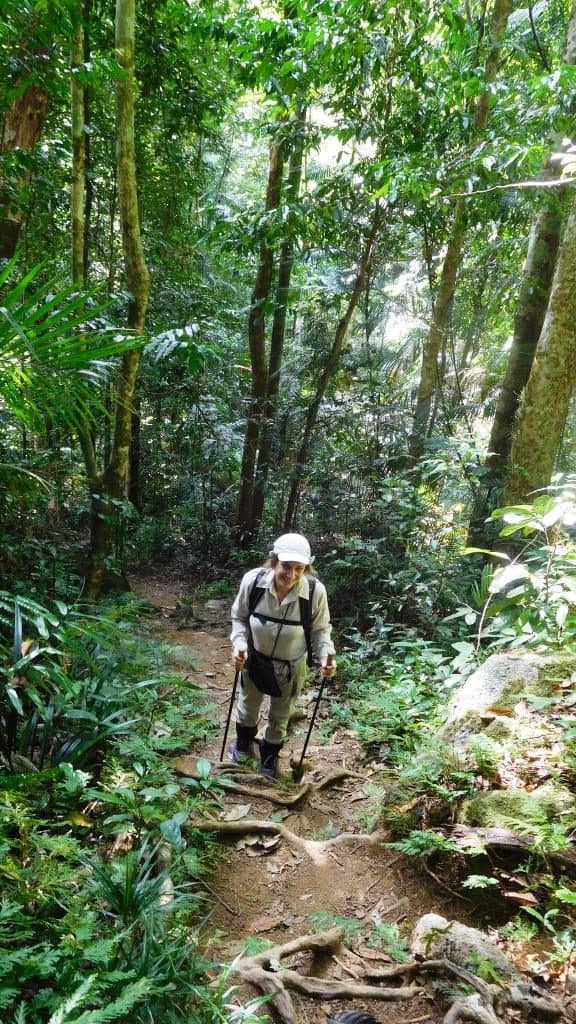
There is some splendid timber.
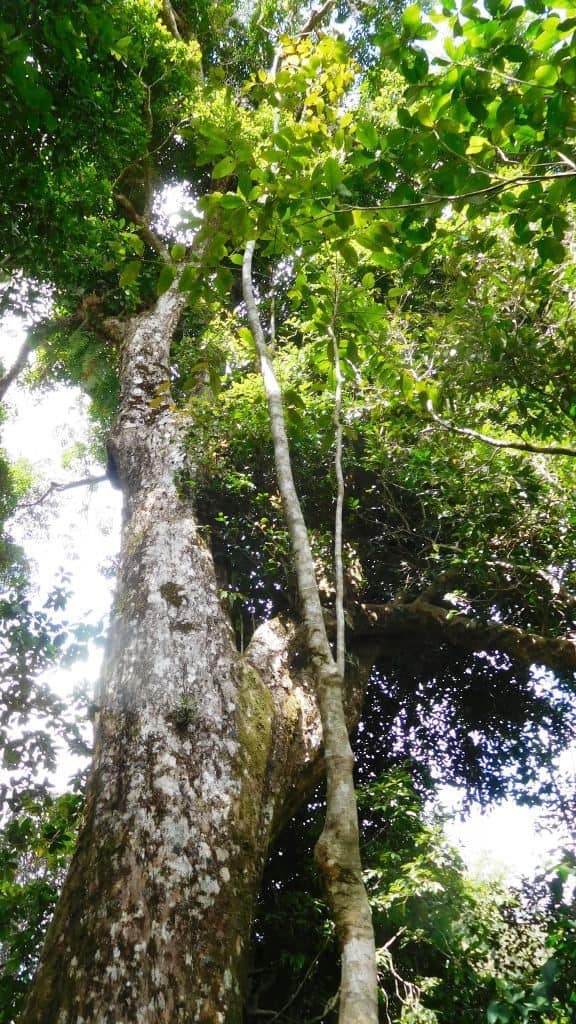
The trail is well cleared, maintained and easy to follow – though of course much more difficult in the boulder field/s.
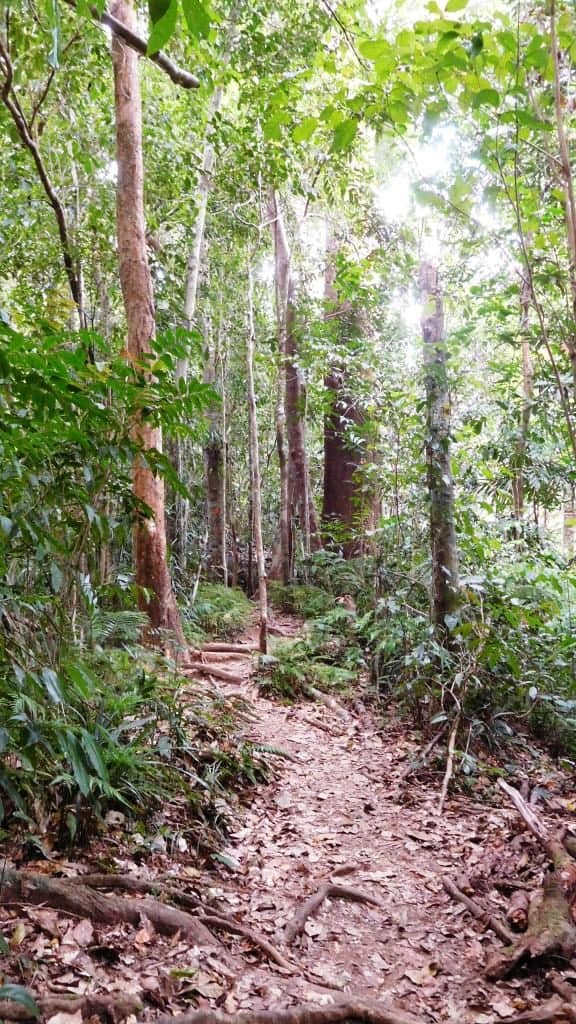
I love the way the figs brace themselves. Any other tree than this would have fallen.
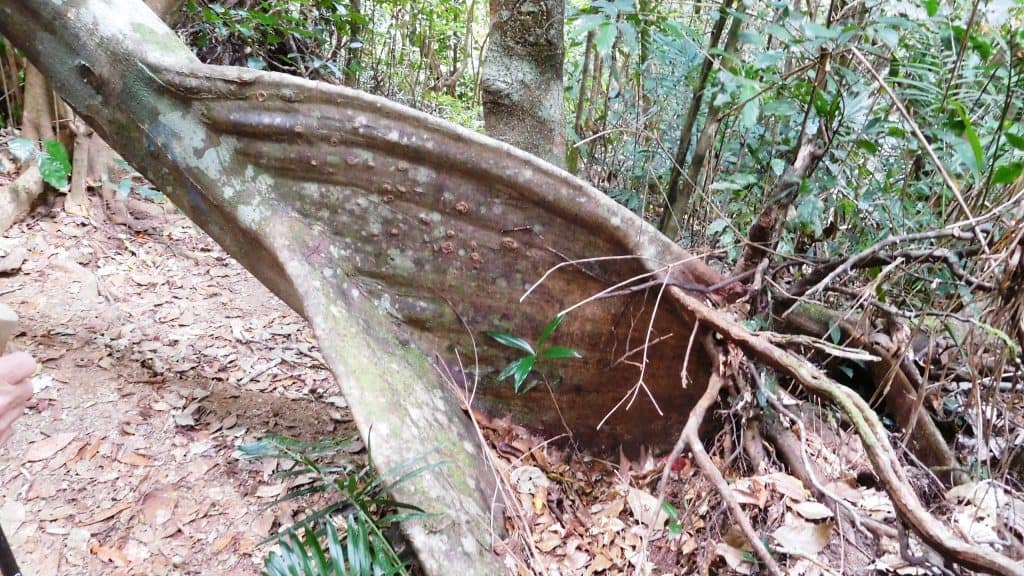
Lunch stop a little before the 5 km mark at about 2:30pm. Our new Topo Terraventure shoes performed really well.
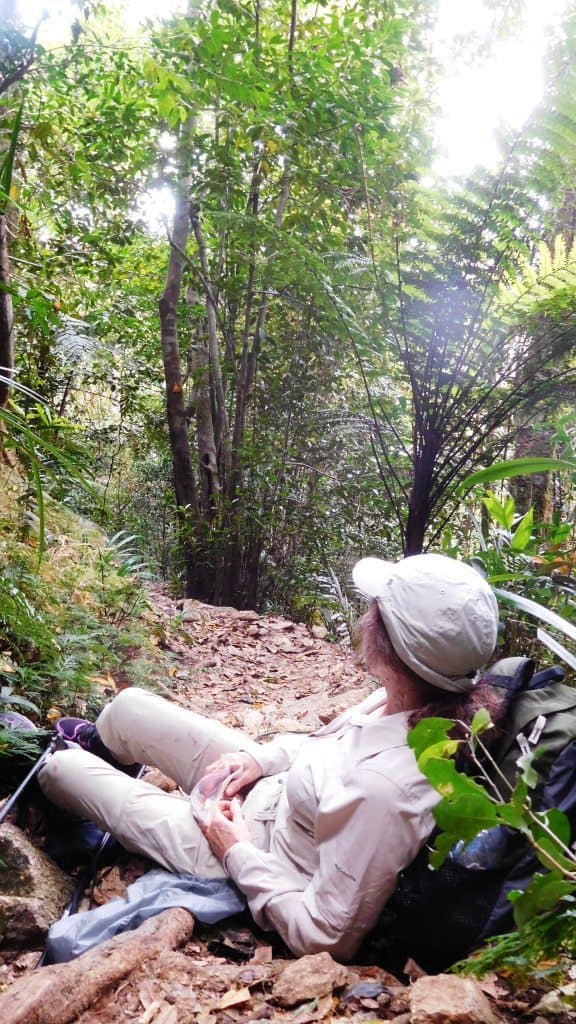
And then more up and up over rocks and tree roots. It is impossible to capture the steepness in a photograph.
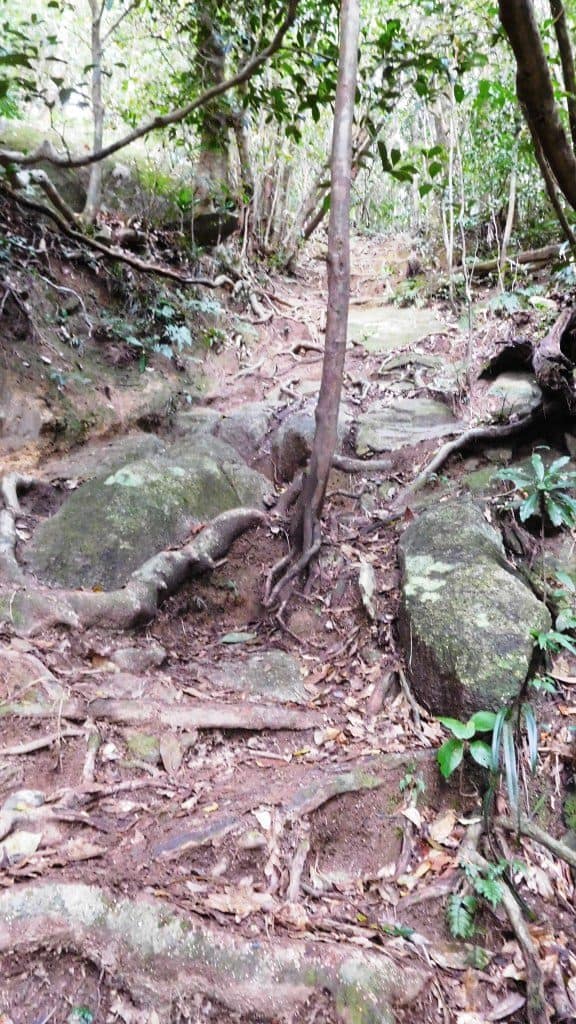
Now and then you get a glimpse of the Johnson River Valley far below – but it is rare. The canopy is thick.
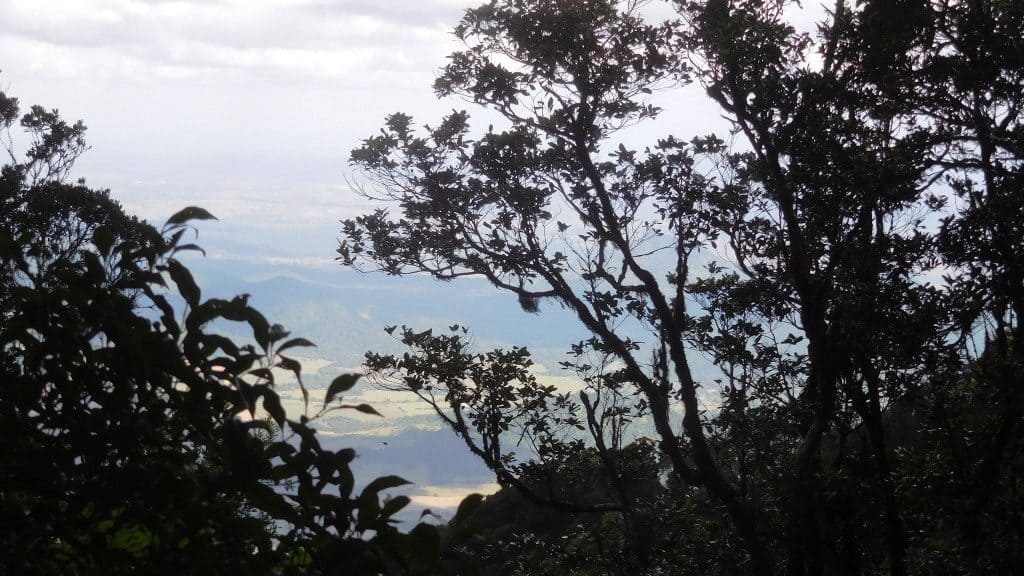
Some places you have to pull yourself up ladder-like by tree roots. The section from the Big Rock camp to about the 5km point is the worst, then it is reasonable going again until you reach the first boulder field at about 6.5km. There is a second (worse) boulder field between the hut, helipad and campsite and the true summit. Few people attempt the second boulder field which is (according to the Parks staff), very difficult and often wet and slippery. They have been attaching steel rungs etc to the rocks to prevent people falling. Of course you have to cross this boulder field to get to the Western camp where there is a small stream with water.
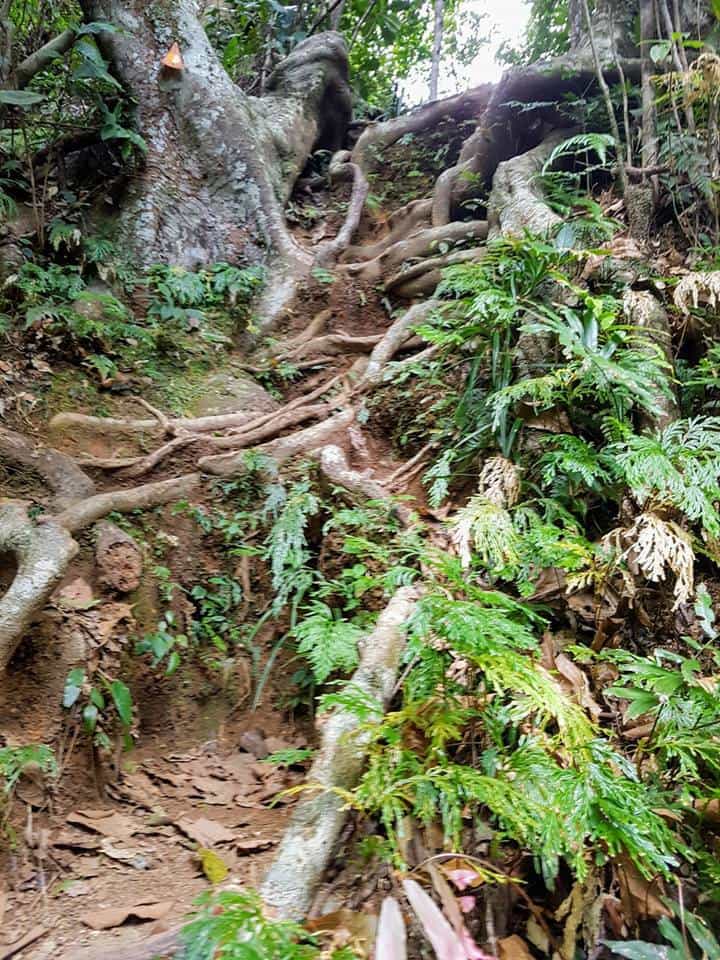
Still, it is very beautiful.
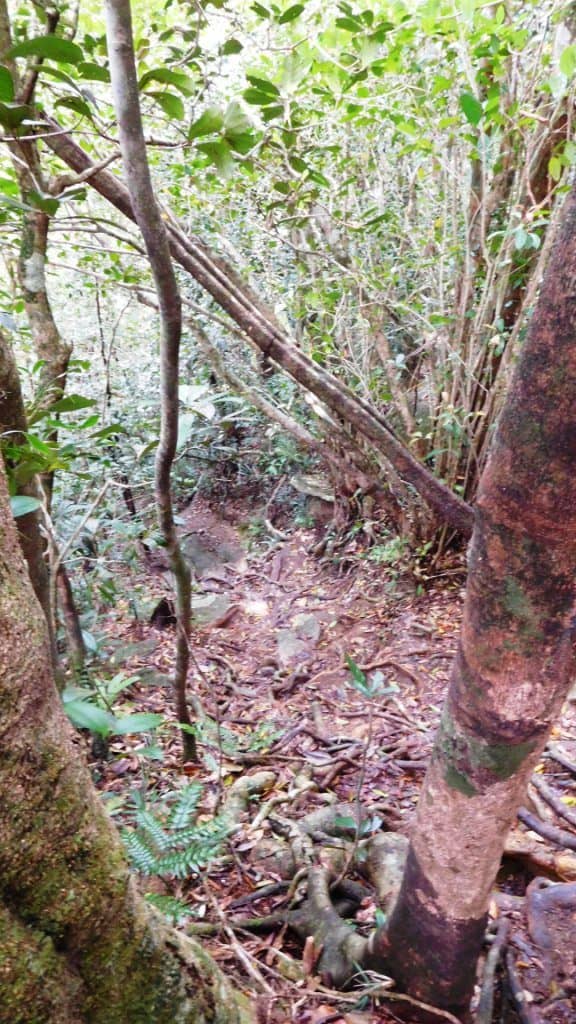
You come to the first small boulder field just after the 5 km mark. It is easy to pass by.
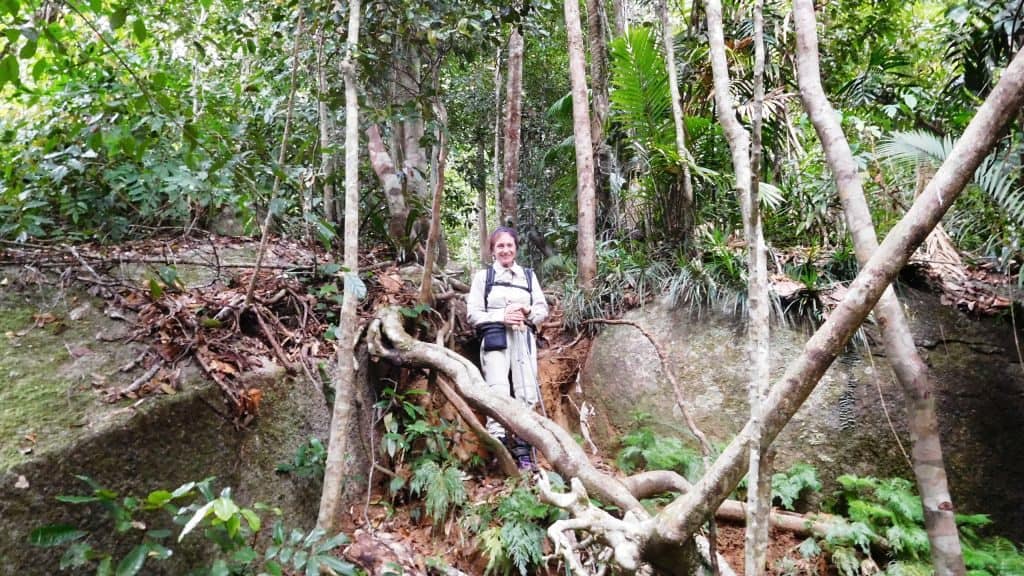
Some wonderful trees along the path. Look at this wonderful forest giant!
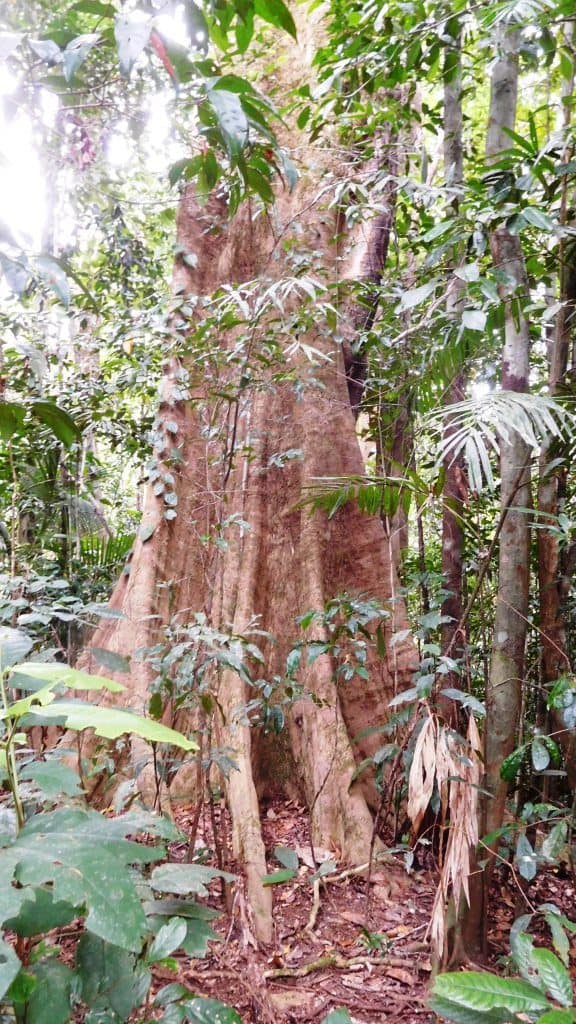
We camped just after the 6 km point, one and one half hours from the summit (going up – it only took one hour going down). At this point probably 1320 metres up there is a quite flat section along the ridge about 200 metres long. There are already a couple of spots where you can put up a small tent. If you carried a small saw you could easily create another 4-5 camp spots just by removing perhaps 1-2 plants of approx 1″ diameter. (See: http://www.theultralighthiker.com/ultralight-saws/) This is a good place to spend the night as it is warm, sheltered and out of the wind. You can hear a stream running over to the East about 300 metres away. It would be good if Parks staff could create such campsites here and a short path to the stream as a water supply point. This would make the climb so much easier and relieve much distress and danger.
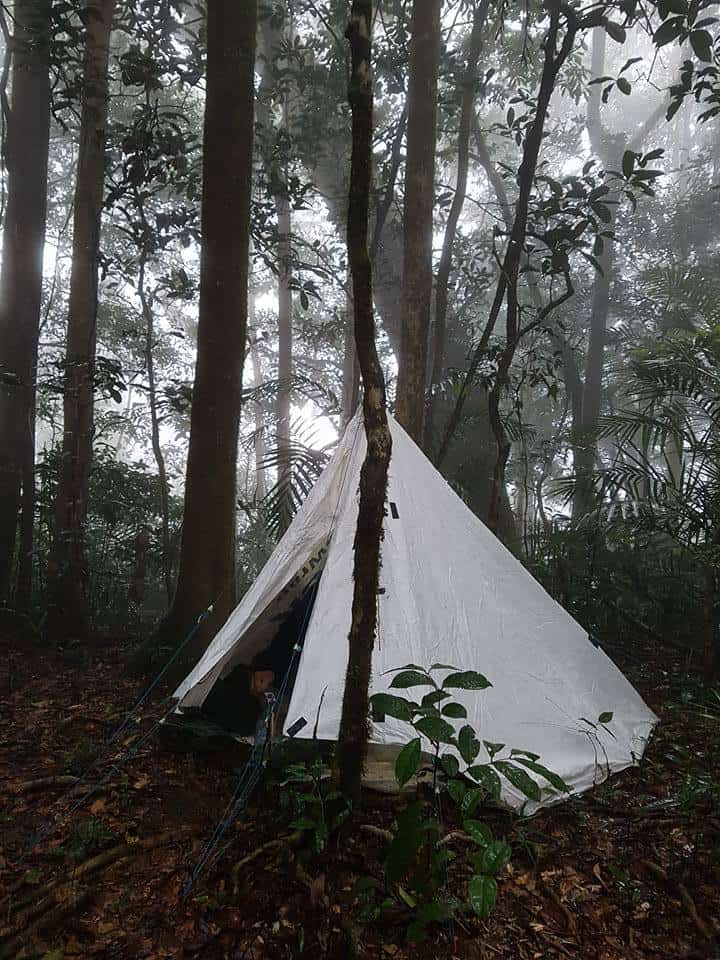
This is my prototype of the ‘Deer Hunter’s Tent’ which has been with us to quite a number of places now. Soon I will make a final edition of it which will weigh around 200 grams. (Have done: Deer Hunter’s Tent #2). You can see Della is enjoying the shelter and the rest. I imagine it always rains here over night. This is a cloud forest after all.
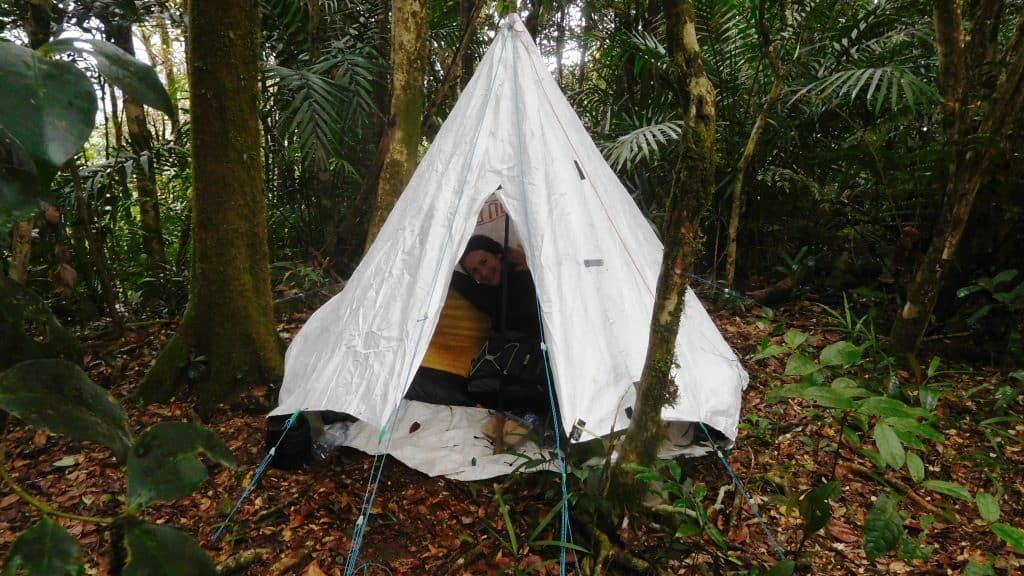
Next morning this was the view out our front door. The cloud added a truly magical element to the experience.
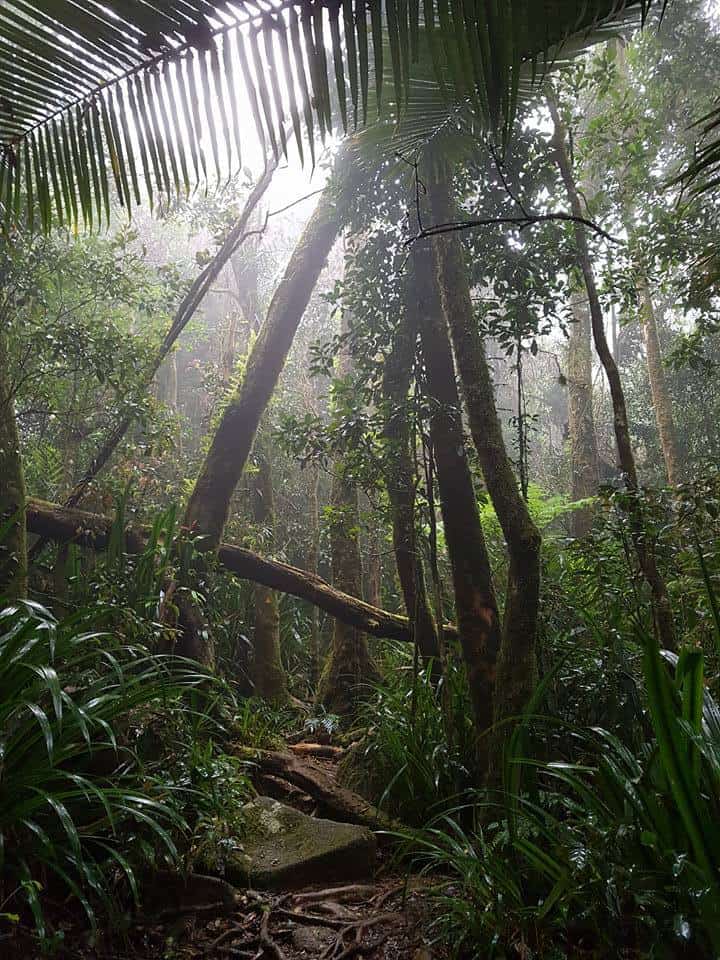
And then it was onwards and upwards once more to the summit (taking only a day pack)
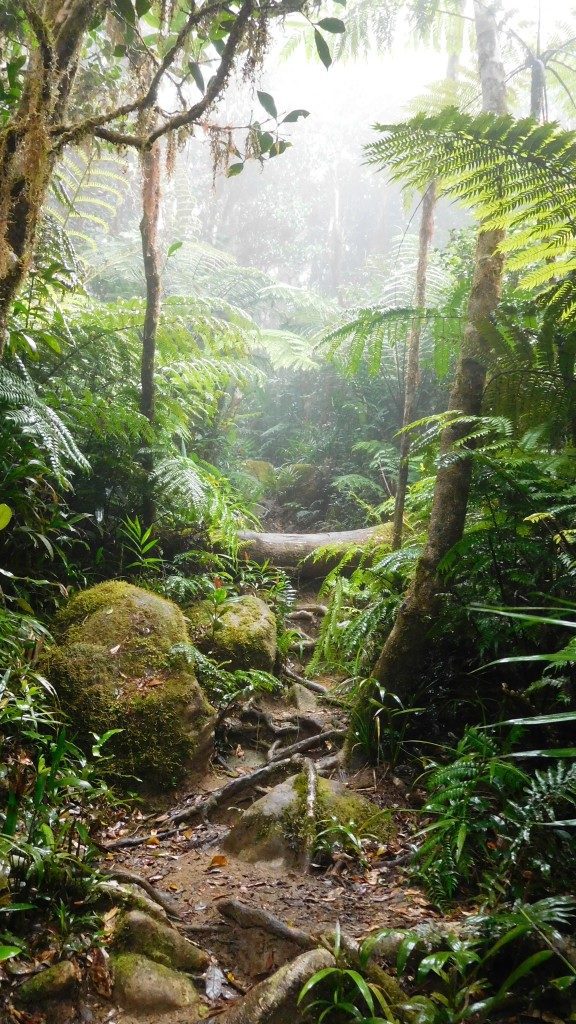
The cloud prevented any view of anything other than clouds, but I thought it was quite beautiful nonetheless.
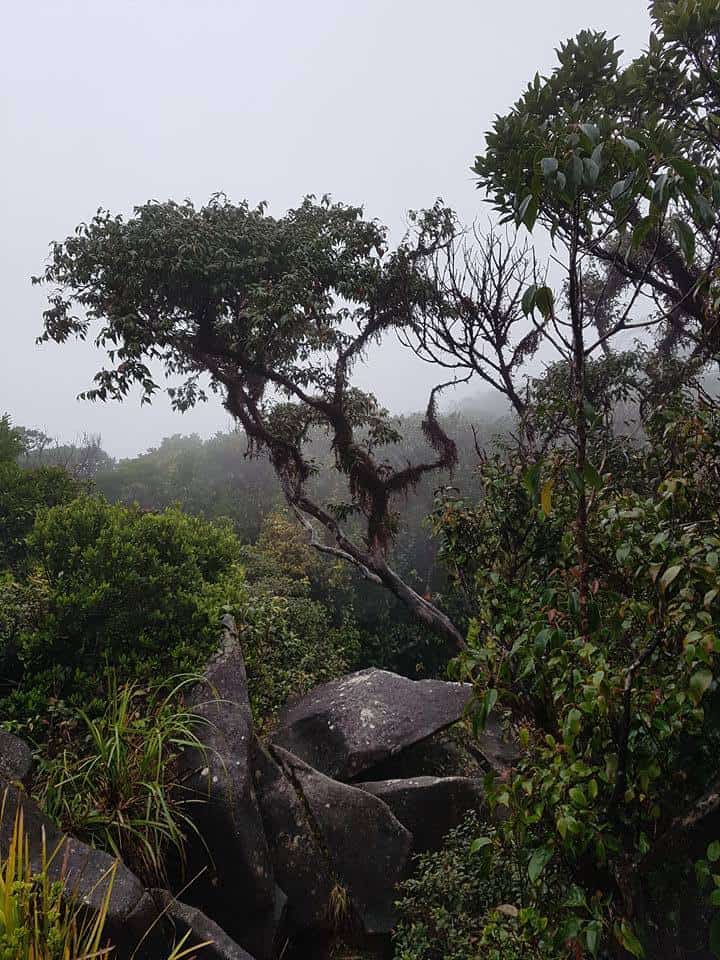
Sometimes the clouds were very thick. You can imagine getting into difficulty with route finding here in poor light. It is also very difficult for Parks staff to mark the route through all these rocks.
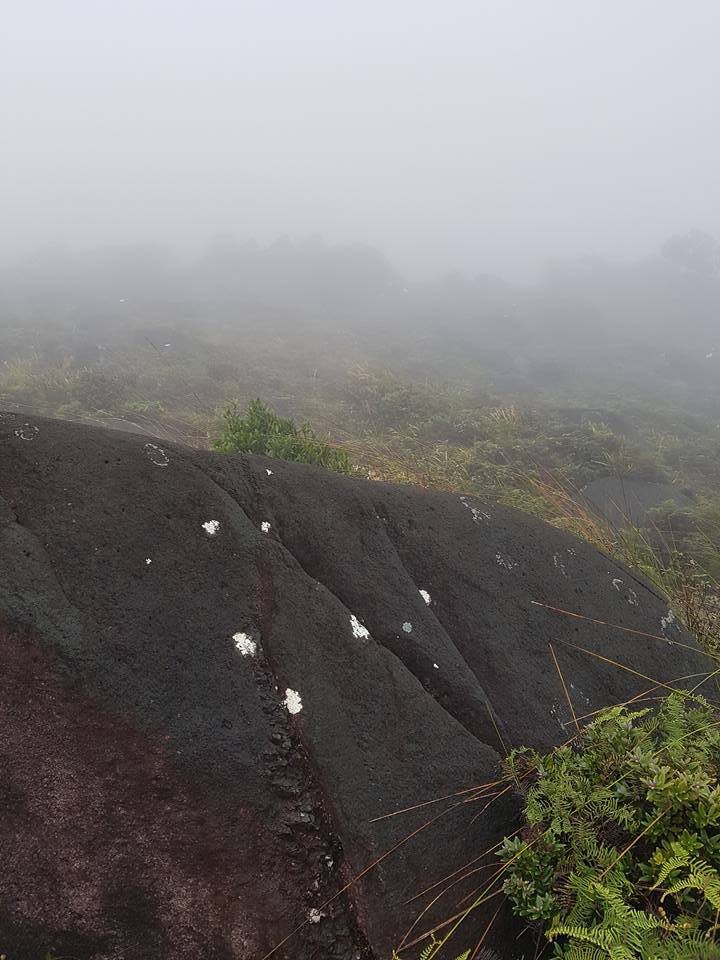
You have to cross a quite difficult boulder field before you get to the hut etc. There are nooks and crannies amongst the boulder field where you might shelter (eg for the night) if you had to. Sometimes there are very small pools of water (1-2 litres) on top of large rocks or in tree hollows which might save your life if you had not brought enough water – but please don’t count on them.
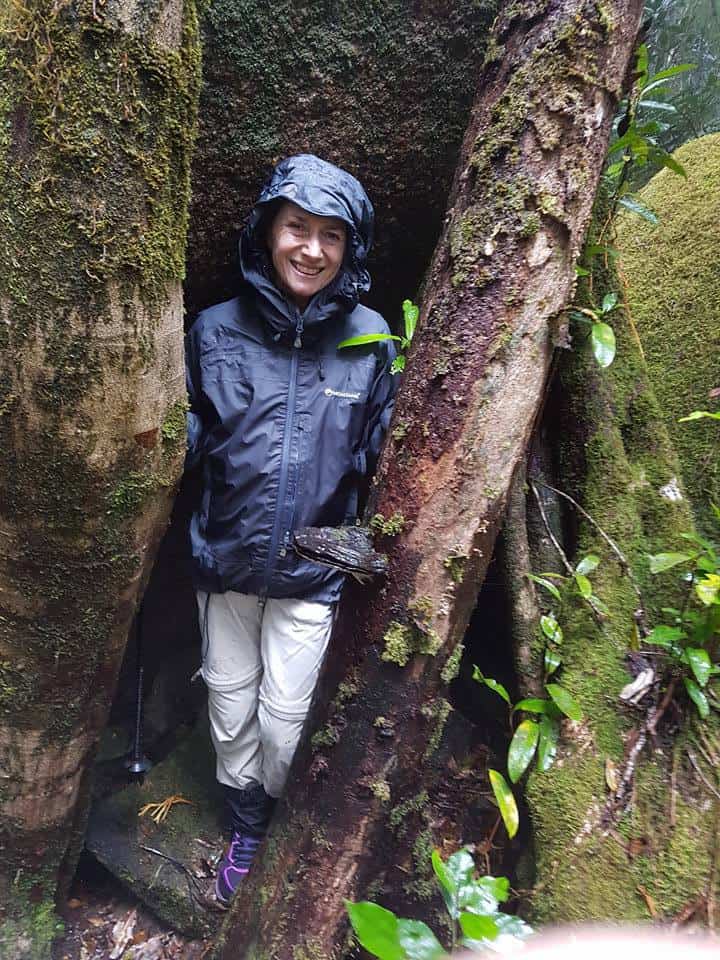
It is quite a scramble and balancing act in places. The rocks can be quite slippery. You need to take it slowly and carefully.
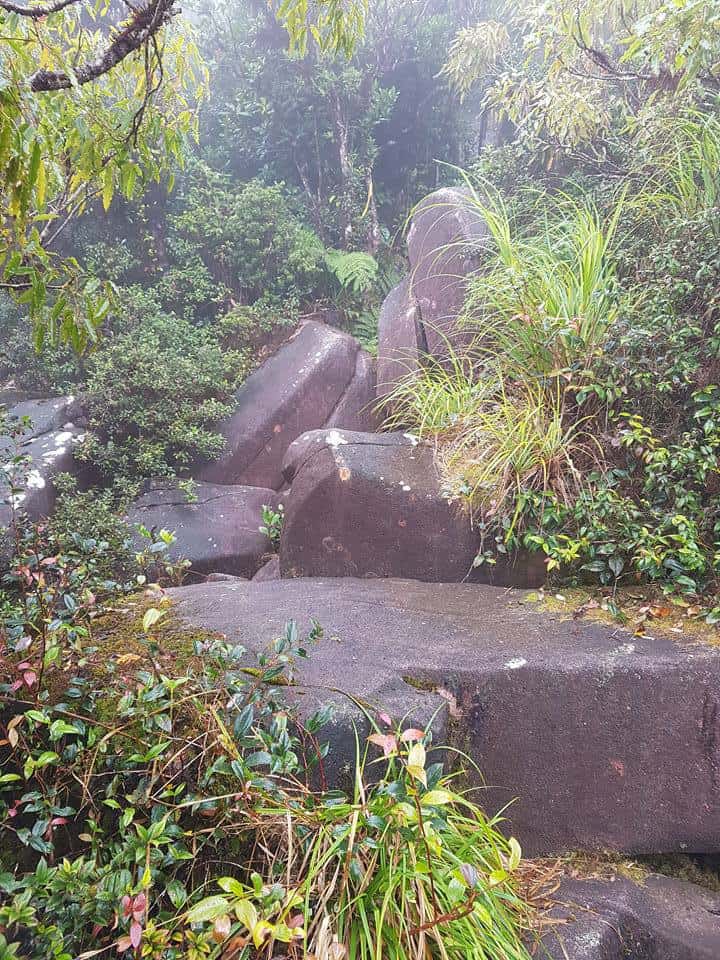
Della clinging on for dear life (and loving it)!
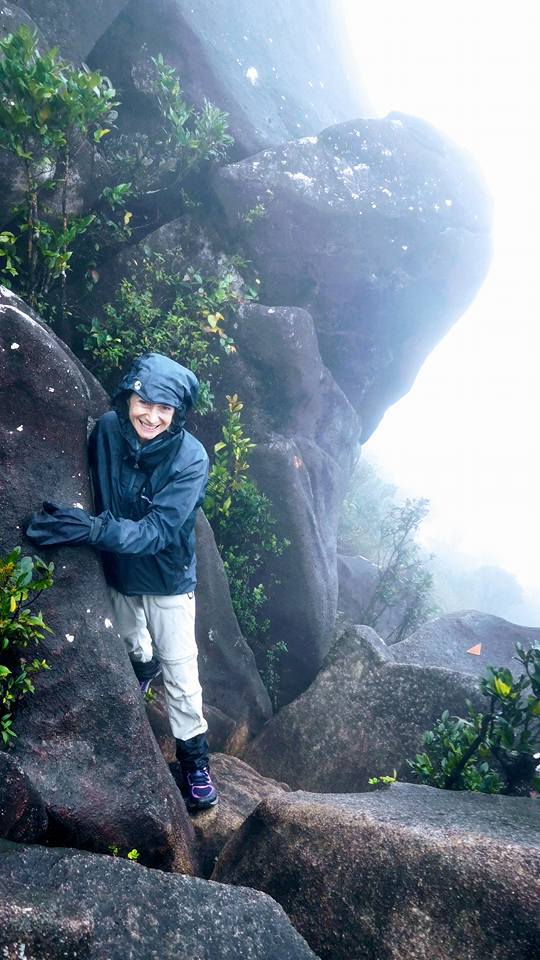
Then finally, we arrived at the ’emergency shelter’ hut.
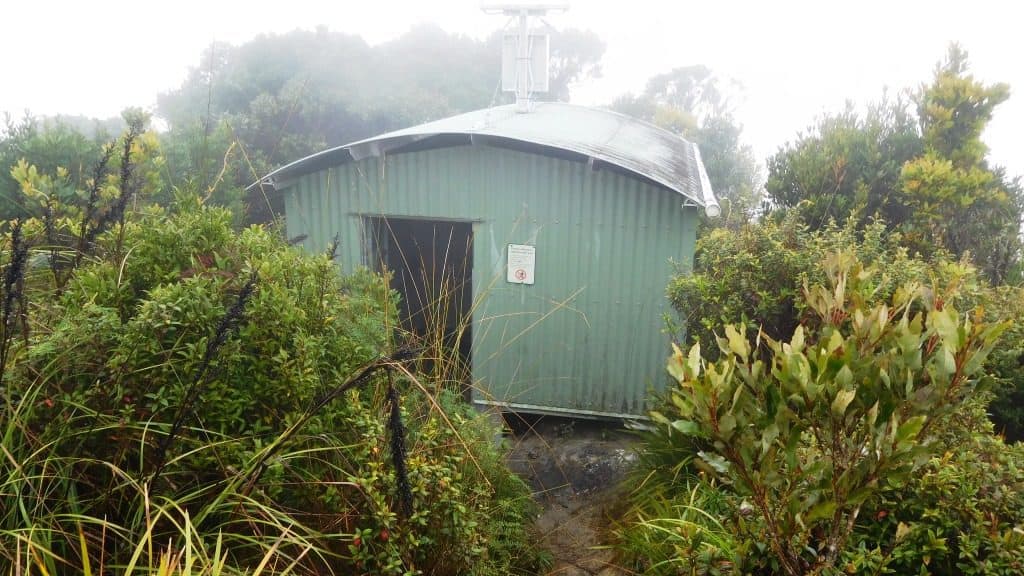
As you can see it is built entirely of metal. Disgustingly, people have left a lot of rubbish here. Some idiot has lit a fire within 1′ of the structure. People! If you had to shelter here, the dew would rain off the roof onto you. The aluminium ‘sleeping’ bench would be exceedingly cold if you had no insulating mattress.
Parks would probably be advised to bolt a sheet of marine plywood to it to prevent people developing hypothermia. A couple of emergency ‘space blankets’ provided for the unprepared and foolish might also be a good idea. I know the hut is only provided for the foolish, but stupidity remains the only ‘crime’ still punishable by death in Australia – and every year numbers of people are so sentenced!
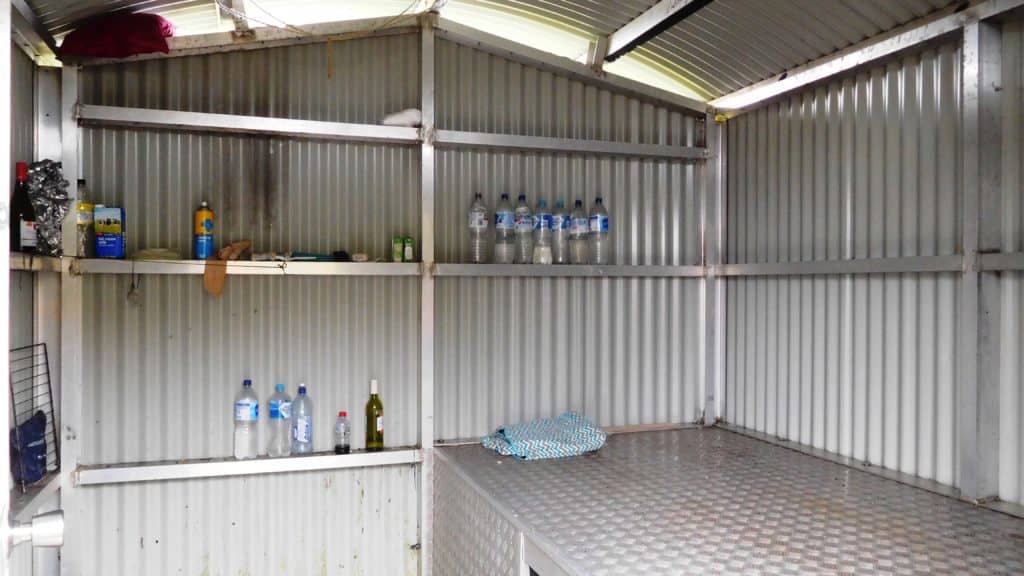
The helipad is only metres away. You can see from the cloud cover that it is often very dangerous for helicopter pilots to land here. The pity is they may have to so (endangering their own lives) due to someone else’s folly! 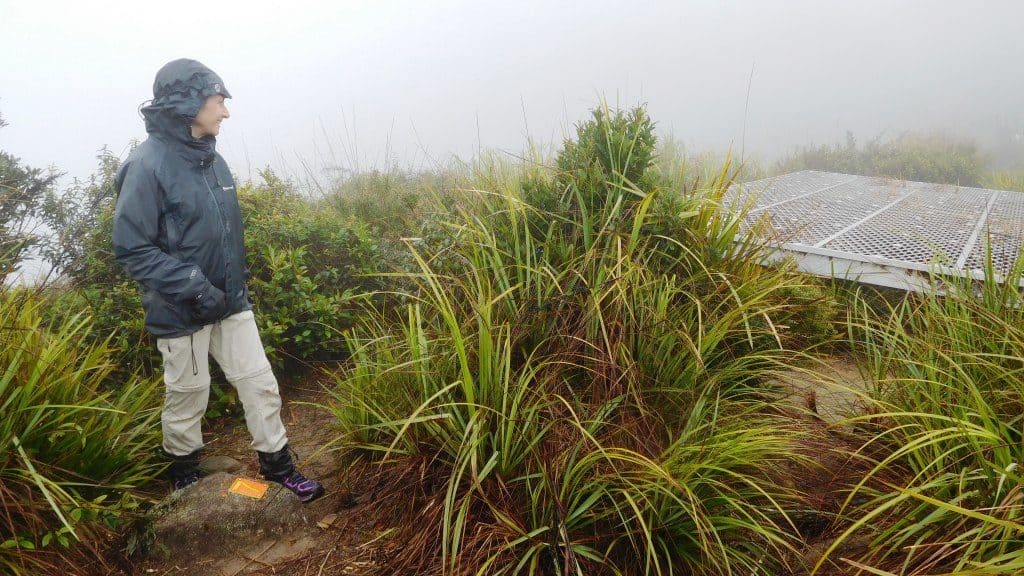
As you can see, the only view on the day we were there was of cloud, beautiful cloud.
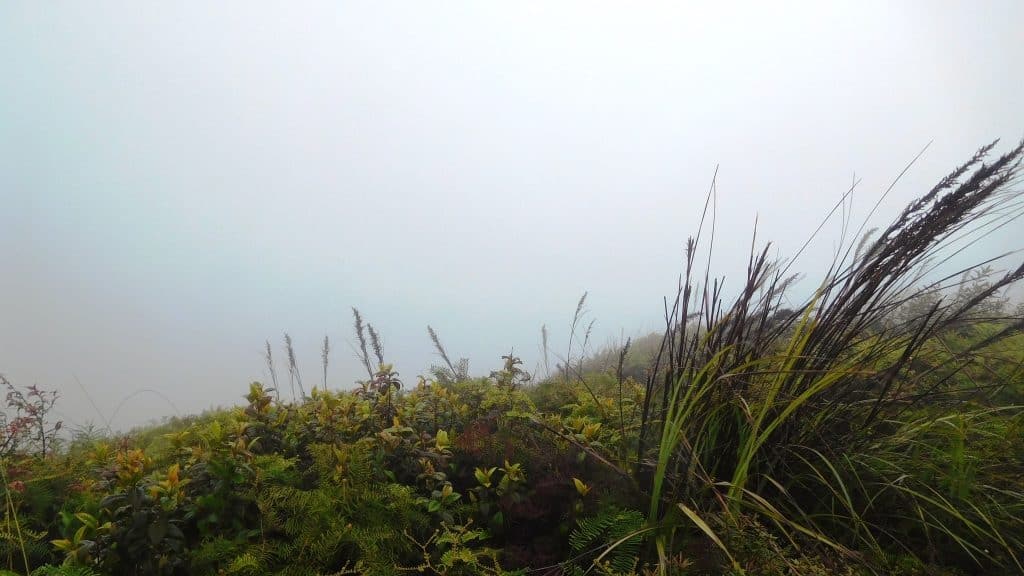
And very interesting shrubbery.
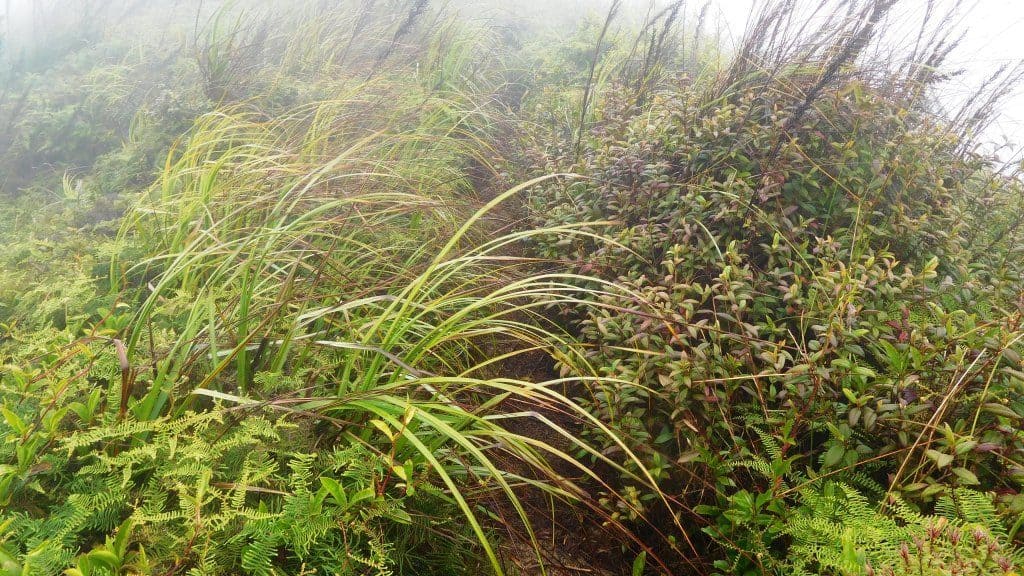
And of course the obligatory informational plaque! There is always a rare lizard in such places! Even so, nearly three quarters of Australia’s wildlife is to be found up here in these cloud forests. We will later on be walking the ‘Misty Mountains’ walk near Ravenshoe.
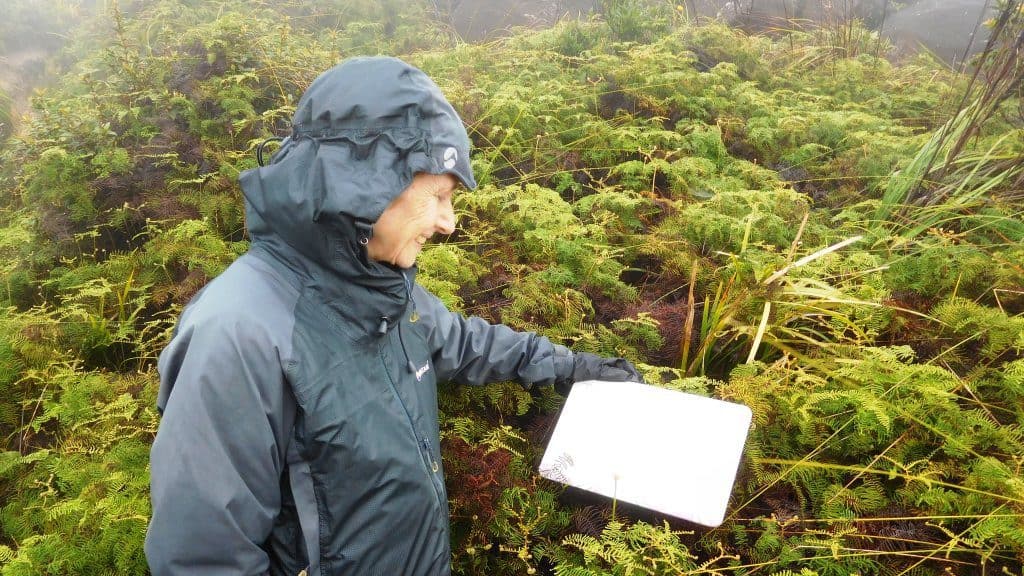
The (flooded) campsite (which has to be booked (though few do – we did, but it did not prevent double booking, at least someone else camped there the night we were to do so!) would only accommodate one tent really, maybe two but you would have to squeeze.
There is no water at the summit. Parks could install a small plastic water tank attached to the hut (with a foolproof tap – if such exist!) which might be a life-saver! It would always be full due to the cloud forest dropping heavy due, mist or rain every night – unless some idiot managed to leave the tap on!
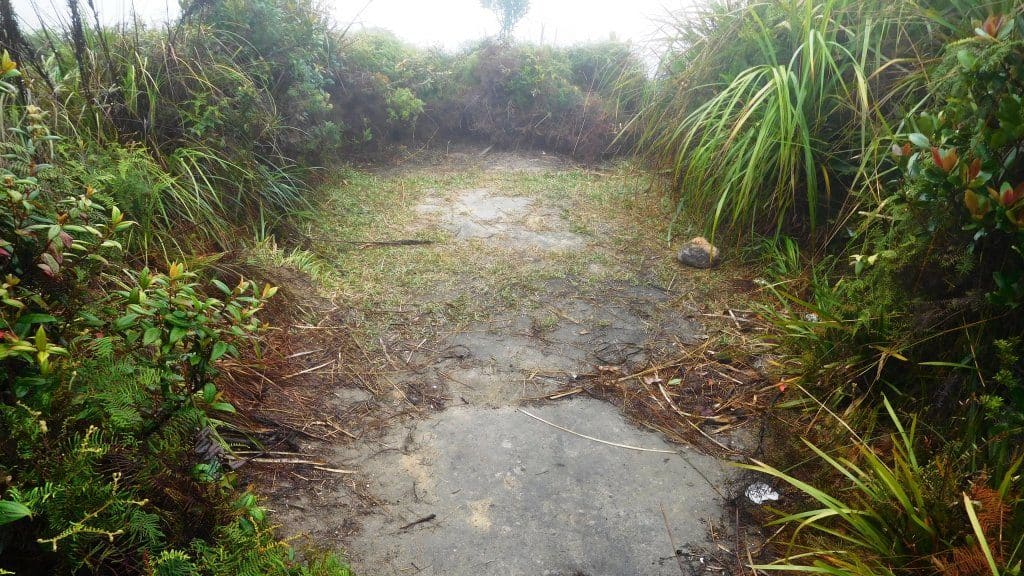
In retrospect we should have planned to walk over the summit to trail’s end then come back again, though Della at least – because of her eyesight, would have had difficulty with the summit boulder field – which we could not even see in the mist, but apparently it is horrific. Another time – we will certainly do this trip again. There are two other campsites to the west.
Altogether it took us 8 1/2-9 hours to walk to the summit and 7+ hours to walk back to the car park. I know we are not young, but really it is not a day walk. Nonetheless it was a most enjoyable walk which we would recommend to practically anyone who is reasonably fit.
We encountered two pairs of day walkers (and three overnight people – so the track is not crowded). One pair of ‘day’ walkers were coming down in the afternoon at 3:30pm and were still well above the 5 km point which it had taken us over 6 hours to get to! One of the two girls was already clearly close to tears. The other pair we met as we were coming down the next day (and they were going up ) at about the same point at 1:00pm after we had already been walking down from the summit for 2/12 hours. Clearly they were not going to make it up and back anywhere before dark either. One of the young fellows was already quite ‘knocked up’ too, it seemed to me. Not a recipe for a good time! We told them so too, but they continued on. Hope they made it all right.
In retrospect we would have been better to have camped at Big Rock camp on the way down, even though it was only a bit over 2 hours more back to the car from there – as that two hours quite exhausted both of us, and achieved nothing really. (Some really bad take-aways in Innisfail really – we chose the wrong cafe!)
Big Rock is a really pleasant spot to camp. There are several tent sites, and evidently good eel fishing! If I did the trip again I would take three days to the summit and back or a couple of more to trail’s end and back.
I would also consider an extra day whilst camped at Big Rock, to walk up to Broken Nose and back (as a day trip). Apparently there are (usually) great views from that point – but a dreadful track!
Hope you enjoy your Bartle Frere walk as much as (or more than) we did! Cheers!
Originally published 10 Oct 2017.
See Also:
http://www.theultralighthiker.com/cairns-2/
http://www.theultralighthiker.com/cairns/


Russell River not the Johnstone. Water
Is available if you walk down on the left side (going upwards) from the helpad. It is a soak, not a running stream.
Very useful advice. Thank you Warren. A cleared track to it would be a blessing. Could you be a little more precise please – your advice is a little ambiguous. Cheers, Steve.